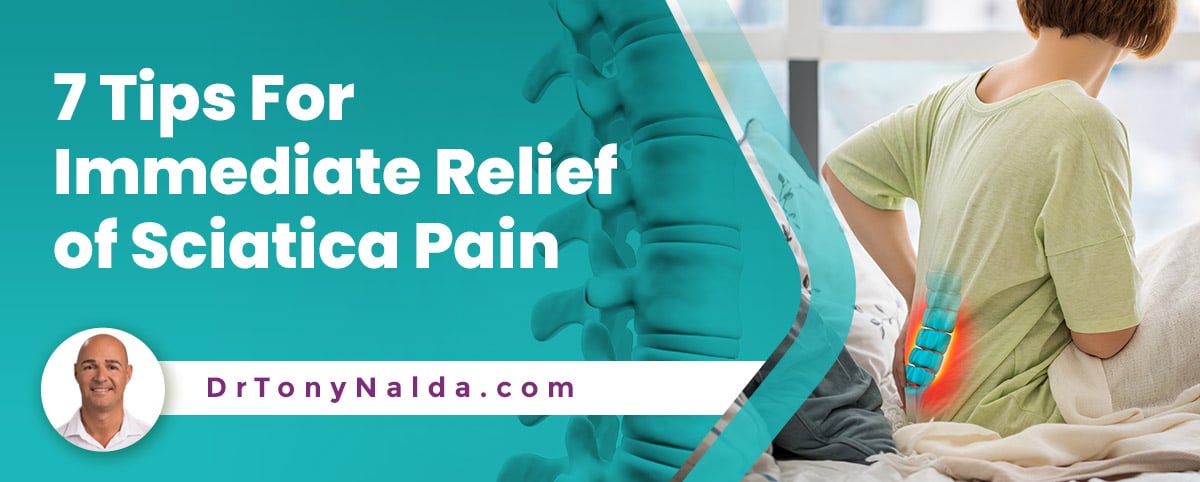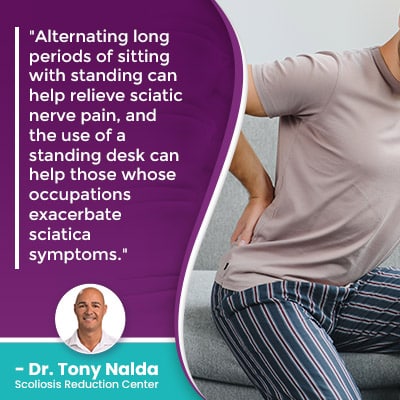7 Tips For Immediate Relief of Sciatica Pain

When it comes to sciatic nerve pain, it can be felt anywhere along the nerve's extensive pathway starting in the lower back and extending down the buttock, leg, and into the foot. When it comes to tips for pain relief, the best approach is proactive treatment that addresses the sciatic nerve pain's underlying cause.
Sciatica is not a condition itself, but rather refers to the symptom of sciatic nerve pain. When the sciatic nerve is exposed to uneven forces, it can become compressed, impinged, and/or damaged, and the best way to relieve pain is through proactive treatment shaped by causation.
Let's talk about the sciatic nerve, before moving on to specific tips for immediate relief for sciatica pain.
Table of Contents
The Sciatic Nerve
 The sciatic nerve is a mixed nerve, containing both sensory and motor fibers, which is why sciatic nerve issues can affect movement and sensation.
The sciatic nerve is a mixed nerve, containing both sensory and motor fibers, which is why sciatic nerve issues can affect movement and sensation.
The sciatic nerve starts in the lumbar spine (lower back) and extends down the buttock, into the left, and foot.
In most cases, sciatica affects the left side of the body, but it can affect the right, and in rare instances, both sides of the body can feel its effects.
Nerves are like branches of a tree, fanning off in multiple directions, which is why symptoms of nerve compression can be felt throughout the body.
If the sciatic nerve root is compressed where it exits the lumbar spine, the uneven pressure at the nerve root can cause symptoms felt far from its site of origin, and this is an important feature of radicular pain to understand; for example, sciatic nerve pain felt in the foot can be easily mistaken for a foot issue/condition, when the foot is hurting due to radiating nerve pain, not an issue within the foot itself.
When it comes to nerve compression, determining its underlying cause is the first step to potentially relieving nerve pressure and alleviating its symptoms.
Before getting to tips for pain relief, let's talk about the nature of sciatic nerve pain.
What Does Sciatica Feel Like?
While each patient's sciatica experience will be unique and symptoms are shaped by causation, severity, and patient age, some common symptoms of a compressed sciatic nerve can include:
- Lower back pain
- Radiating pain in the buttocks
- Radiating pain in the left leg
- Radiating pain in the foot
- Sensations of tingling and/or numbness felt anywhere along the sciatic nerve's pathway
- Shooting pain throughout the lower body
- Lower body mobility issues can develop over time
Radicular pain can flare up intermittently, or be chronic and debilitating, and sciatic nerve pain can also involve electric shock-like sensations.
It's estimated that approximately 40 percent of people will experience sciatic nerve pain at some point in their lives.
Sciatica has a number of causes, which we'll touch on while discussing pain relief options, and certain lifestyle factors such as obesity, smoking, and low activity levels can increase the likelihood of sciatic nerve issues.
Sciatica Treatment Options
When it comes to treating sciatic nerve pain, it's important to remember that as sciatica isn't a condition itself, sciatic nerve pain is a symptom of an underlying issue, so for any sustainable long-term pain relief potential, its underlying cause has to shape the design of effective treatment plans.
Some common causes of sciatica are negative lifestyle choices, as mentioned, to intervertebral disc issues and a variety of spinal issues/conditions such as spinal stenosis, spinal bone spurs, and scoliosis.
So once causation is determined, proactive treatment will focus on addressing the underlying cause of the sciatic nerve compression.
Now that we've addressed sciatica treatment needs generally and some of the common causes of sciatic nerve pain, I'd like to provide 7 tips for sciatica nerve pain relief, starting with the most important: proactive treatment.
1) Professional Proactive Treatment
When it comes to sciatic nerve pain, finding a treatment provider that is more dedicated to determining its cause, than merely prescribing pain relief medication, is key to sustainable long-term pain relief.
The problem is the longer the sciatic nerve is exposed to uneven pressure, the more irritated it's likely to become, and the more likely neuropathy and permanent nerve damage is.
So the best way to address sciatic nerve pain is to have an official diagnosis that addresses the underlying cause of the sciatic nerve pain.
2) Physical Therapy
Physical therapy can help target lifestyle issues that are contributing to sciatica such as obesity, low activity levels, and or chronic poor posture.
Physical therapy can help with increasing core strength so pressure is taken off the spine, and its individual parts, as it's optimally supported by its surrounding muscles.
Through physical therapy, muscles can be strengthened, preventing tight muscles and tense muscles.
When the cause of sciatica symptoms are disc issues, physical therapy (specific exercises and stretches) can help improve disc health/function by increasing blood flow around affected discs.
Sciatica-specific exercises and stretches can also help relieve pressure on the sciatic nerve, providing immediate pain relief.
3) Weight Loss
As mentioned, obesity is a lifestyle issue that can be addressed for long-term sciatica relief.
Carrying excess weight means the body's joints, including the spine's, are strained, and this can cause uneven wear, and increase the risk of injury.
Increasing activity level is key to maintaining health and wellness across the board, and when it comes to sciatica, studies have shown that regular exercise helps minimize the effects of sciatic nerve compression.
Losing weight can help relieve pressure on the body's joints and nerves, and keeping weight low is a preventative measure that can keep sciatic nerve issues, and a number of other health and spinal issues, at bay.
4) Practice Ergonomic Lifting
Repeatedly lifting heavy objects incorrectly can expose the spine, and its surroundings, to adverse spinal tension, straining the spine and its surrounding muscles, causing uneven wear, and increasing the risk of injury.
Understanding the concept of ergonomic lifting means lifting with the legs, rather than the back.
Particularly for those whose occupations require repeated heavy lifting, being mindful of body positioning while lifting is important; focusing on the legs and bending with the knees and hips, instead of hinging forward at the waist is key.
For those who can't avoid heavy lifting, being mindful of position, plus wearing a lifting belt, or some form of lumbar support, can help facilitate relief from sciatica pain.
5) Chiropractic Care
Chiropractic care can help address severe pain caused by sciatic nerve compression related to a number of issues, and as the spine's intervertebral discs are commonly the first spinal structures to deteriorate, they are at the root of many cases of sciatica.
A spinal disc sits between adjacent vertebrae and helps facilitate the spine's flexibility, provides the spine with structure (adjacent vertebrae attach to the disc in between), and provides cushioning so friction during movement is prevented.
When a disc becomes desiccated, bulging, and/or herniated, it changes shape, loses height, and this affects the positioning of nearby vertebrae that can also shift in position; when this happens, it's not just the vertebrae themselves that are impacted, but also their surrounding muscles and nerves.
When the spine shifts out of alignment due to disc issues, nerve roots can be compressed, and treating sciatica can involve chiropractic care working towards realigning the spine through manual adjustments so uneven pressure on the spine, and surrounding muscles and nerves, is reduced.
As you might recall, sciatica is associated with a number of spinal issues, such as stenosis causing a loss of space within the spine so its nerves have less room to function within, bone spurs that can cause uneven pressure on the spinal nerves, and conditions like scoliosis that involve a loss of the spine's healthy curves; condition-specific chiropractic can proactively address a number of spinal issues/conditions, including helping relieve sciatica pain.
6) Standing up More
When it becomes difficult to manage sciatica pain, finding certain positions that alleviate nerve pressure can help, and for those that spend a lot of time sitting, spending more time in an upright position can help with immediate relief from sciatica pain.
A common complaint of people suffering from sciatica pain is that it increases during/after long periods of sitting (particularly challenging for those with desk jobs), and even with the use of an ergonomic office chair, sitting can still pinch the sciatic nerve and cause excruciating pain.
The growing popularity of standing desks in the workplace attests to the harm that sitting for long bouts of time can do, sciatic discomfort included.
 Alternating long periods of sitting with standing can help relieve sciatic nerve pain, and the use of a standing desk can help those whose occupations can exacerbate sciatica symptoms.
Alternating long periods of sitting with standing can help relieve sciatic nerve pain, and the use of a standing desk can help those whose occupations can exacerbate sciatica symptoms.
Basically, those looking for effective pain relief from sciatica should listen to their bodies; if it hurts to sit, stand, and this can also help provide immediate relief from sciatica pain.
7) Hot/Cold Therapy
When it comes to immediate relief, hot/cold therapy helps with a number of spinal conditions/issues, particularly when it comes to reducing inflammation.
Hot/cold therapy is often a component of physical therapy, and it's a helpful remedy for patients as it can easily be performed at home.
Most cases of sciatica will resolve on their own within a number of weeks, but for those that persist, and/or are caused by an underlying spinal condition, applying ice to the painful area several times a day, at the onset of pain, can help reduce inflammation and provide relief.
Alternating with heat treatment and a heating pad, after the first few days of ice therapy, can also help ease sciatic pain.
Conclusion
After reading my seven tips for dealing with sciatic nerve pain, you'll likely notice I didn't include over the counter medications and/or topical pain medications as a means of reducing pain, and this is because while prescription pain meds can most certainly bring immediate pain relief, they don't impact the pain's underlying cause.
In addition, pain medication can actually mask the fact that a condition is progressing; while no one wants to experience pain, it does serve a vital purpose in communicating that something is wrong inside the body.
Here at the Scoliosis Reduction Center, I've treated a wide range of spinal conditions from stenosis, bone spurs, degenerative disc disease to scoliosis and sciatica.
I integrate a number of conventional treatments and alternative therapies to impact a condition's underlying cause: this is the difference between treating a symptom, or the underlying cause of the symptom.
The first step to providing long-term sustainable relief from sciatica pain is determining its underlying cause and shaping treatment plans around it; when it comes to immediate pain relief from sciatica, hold/cold therapy, changes in position, and a physical therapist can help.
Dr. Tony Nalda
DOCTOR OF CHIROPRACTIC
After receiving an undergraduate degree in psychology and his Doctorate of Chiropractic from Life University, Dr. Nalda settled in Celebration, Florida and proceeded to build one of Central Florida’s most successful chiropractic clinics.
His experience with patients suffering from scoliosis, and the confusion and frustration they faced, led him to seek a specialty in scoliosis care. In 2006 he completed his Intensive Care Certification from CLEAR Institute, a leading scoliosis educational and certification center.
About Dr. Tony Nalda
 Ready to explore scoliosis treatment? Contact Us Now
Ready to explore scoliosis treatment? Contact Us Now





